Abstract
Background: Tubular reactors have wide applications in various industries, namely, ammonia synthesis, oil cracking, gasoline production, and sulfur dioxide oxidation to sulfur trioxide. The most common reactor is the tubular flow reactor. This article aims to study the variation of outlet concentration and temperature on different parameters, like Reynolds number, Prandtl number, and Peclet number, which determine the performance and conversion of reactants. This article shows the temperature and concentration profiles of various parameters.
Methods: In the analysis of the first part of the article, a different governing equation of a nonisothermal tubular flow reactor has been described. The non-dimensionless form of the governing equations has been derived by applying different boundary conditions. COMSOL Multiphysics software was used (version -5.6) to solve the coupled governing equations (non-linear PDE).
Results: The plots of various parameters like Reynolds number, Prandtl number with outlet temperature, and conversion have been shown. The temperature and concentration profile for certain conditions are also shown.
Conclusion: The variation of parameters shows how strongly they depend on the net conversion of reaction. The thermal effects should be taken care of as the heat of the reaction is very sensitive to converting and forwarding the reaction. Proper temperatures must be maintained for highly exothermic reactions; a real-life process is Haber’s process of ammonia production.
Keywords: Tubular reactor, prandtl number, peclet number, reynolds number, COMSOL multiphysics, non-isothermal.
[http://dx.doi.org/10.1016/S1385-8947(00)00360-0]
[http://dx.doi.org/10.1016/j.icheatmasstransfer.2004.10.029]
[http://dx.doi.org/10.1016/S0735-1933(03)00059-9]
[http://dx.doi.org/10.1016/j.ces.2007.01.029]
[http://dx.doi.org/10.1021/ie001035a]
[http://dx.doi.org/10.2174/187221212801227202]
[http://dx.doi.org/10.2174/157341371130900096]
[http://dx.doi.org/10.2174/187221207782411647]
[http://dx.doi.org/10.2174/2405520410666170620105102]
[http://dx.doi.org/10.2174/2666145414666210525162051]
[http://dx.doi.org/10.1016/j.enconman.2018.06.108]
[http://dx.doi.org/10.1016/0923-0467(95)06097-9]
[http://dx.doi.org/10.2202/1542-6580.1152]
[http://dx.doi.org/10.1016/j.compchemeng.2019.06.035]
[http://dx.doi.org/10.1016/S0009-2509(03)00119-2]
[http://dx.doi.org/10.1002/aic.690400110]
[http://dx.doi.org/10.1016/0009-2509(70)85031-X]
[http://dx.doi.org/10.1016/S0009-2509(02)00129-X]
[http://dx.doi.org/10.1016/j.compchemeng.2020.107159]
[http://dx.doi.org/10.1016/0009-2509(72)80045-9]

























